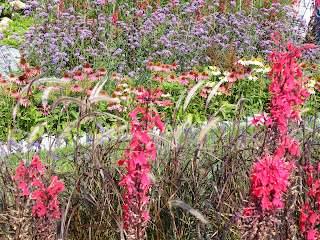The top photo shows the results of dyeing llama fibres with Elecampane flowers in a flask; I was pleased with the resulting golden yellow shade. The second picture shows the dyed Elecampane on the right while the left hand shot is llama fibres dyed with diluted Dye-na- flow paint which turned it a soft, coral pink the latter needs to be heat set.
I have started using the compost from my Bokashi composter. After leaving it in the compost bucket for 2 weeks I dug a trench, put in the partly digested plant material and covered it with soil. On returning to inspect it 2 weeks after that, I found the ground to be friable and free of debris even bones had decomposed. As the weather has been fine I have planted out garlic, shallots and onions to overwinter followed by peas and broad beans.
I am a textile artist living in the Isle of Man. I live on a farm which provides plenty of inspiration and resources for my craft. I am a mixed media artist and love to experiment but I do have a particular love for working with plant dyed fibres. The dyes are prepared using the vast amount of material in my forest garden. The garden is primarily a wildlife refuge but also supplies abundant food, medicines and photographic opportunities. Contact me at pat.rhaa@gmail.com
Saturday, 29 September 2012
Thursday, 27 September 2012
u3a herb group Sept
The u3a herb group met in Laxey where we initially discussed my trip to the Chelsea Physic Garden followed by a short tour round my forest garden. We are keeping herb related information in files, one of them contains recipes which we share around the group. I have been harvesting some of my dye plants; dyers chamomile[Anthemis tinctoria] and elecampane[Inula helenium], the latter I have not used before so I will keep you posted on that. There is a photo below left. I see that elecampane has many medicinal uses, it contains many vitamins and minerals so strengthens the immune system, lowers cholesterol, is used against chronic bronchitis and helps restful sleep. It is the elecampane root that is mostly used medicinally. Further to my blogs on fibres I have posted a photo of my work below called rebirth. It is based on the birthing cloths used in Africa. I used an interesting combination of fibres; ivy dyed wool, some cashmere and llama fibres which give the fluffy white appearance. I then embellished it with beads. the whole piece had a delightful soft feel and was extremely light.


Saturday, 22 September 2012
fibre plants
On my recent trip to London I visited the Chelsea Physic Garden where I found information about fibre plants.The first photo shows ropes made from various plant fibres: they were Flax and Sisal. Flax is one of the oldest fibre plants, its use to make linen goes back to at least ancient Egyptian times. Parts of the plant are also used to make cloths, dye , paper and fabric. The fibre is extracted from the bast of the stem. It is soft, lustrous and flexible.[ See an interesting article on eco interiors from the Telegraph on the web, also look at fiber-images.com for more information on both plant and animal fibres.]
Sisal is an agave that produces stiff fibres that are used in the making of rope, mats and even dartboards! Brazil is the main producer of sisal, during production the leaves are beaten with a rotating wheel with blunt knives to leave only the fibre. Sisal is used to make speciality papers, can take certain dyes and is used in macrame. Sisal is also used for example in Maharashtra, India to make bags and mats which last a long time and don't need any special care. See the websitecraftandartisans.com>Leaf, Fibre & Stem for fascinatind details about Indian crafts using natural fibres.
Saturday, 15 September 2012
Floriade
Here are the first few photographs of the Floriade which I have recently visited in Venlo, the Netherlands.
The top picture shows outdoor planting in drifts of colour including Echinacea plants which seemed a very popular flower at the event.
The next two shots show some of the flower arrangements in one of the main arenas.
Great use of textured materials such as wood, fibres and stone featured strongly in the very creative displays.
The bottom photo shows a reptile made out of abaca fibres which come from a banana plant native to the Philippines[musa textilis]. The plant is harvested for its fibres which come from the trunk and they were once known as Manila hemp. It used to be used mainly for making twine and rope but now has more specialised uses in the making of teabags and banknotes among other products.
I intend to source some of the fibres and use them in my textiles. I have already used tissuetex which is made from abaca. It looks like tissue paper but is very strong and takes dyes and inks very well. I have used it previously in in my piece of work called Herb Garden. In this case I coloured it with Procion cold water dyes to use as a background for stitch. The bottom photo shows some of the coloured tissuetex. I did also buy some coloured hemp fibres from the shop at the Floriade, these were made in Nepal. I look forward to using them.

Subscribe to:
Comments (Atom)







